Most of us know what a Bonsai tree looks like, but few of us know how to grow or care for one.
In this Bonsai tree guide, we will be providing you with definitive tips and advice on growing and caring for a Bonsai tree so that it looks great and lives a long, long time. Perhaps more than any of your other plants and flowers.
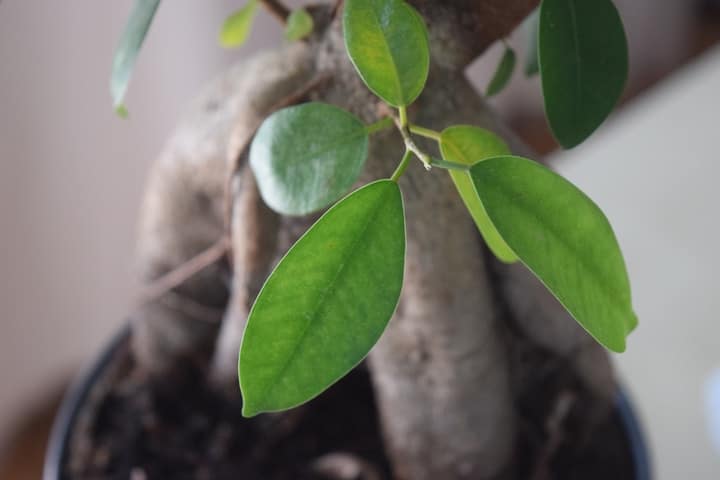
Whether you’re new to the world of Bonsai trees or not, you’ll find below all the essential information you need to get started. And discover lots of ideas too!
Let’s find out how to care for a Bonsai tree. But first…
What Is a Bonsai Tree?
The interesting part here is that while people tend to refer to it as a “Bonsai tree” regardless of its shape, size, etc., there are many types of Bonsai trees, which we will talk about in just a second.
The thing that all these different types of trees share is that they are all cultivated and grown in the same art form—Bonsai (with a big “B”).
This East Asian art form relies on very delicate and precise growing techniques to recreate a tree in miniature size. Literally, the term “Bonsai” translates to “planted in a container.” And that’s what this art is all about, growing a real-life tree in a pot or container.
The scope of Bonsai tree growing is to offer a sort of tribute to the amazing nature that surrounds us and hold up a mirror to it.
Note: A common misconception about Bonsai trees is that they are genetically dwarfed plants, but that is not the case. You can grow a Bonsai tree from pretty much any tree species, as we will see below.
Types of Bonsai Tree
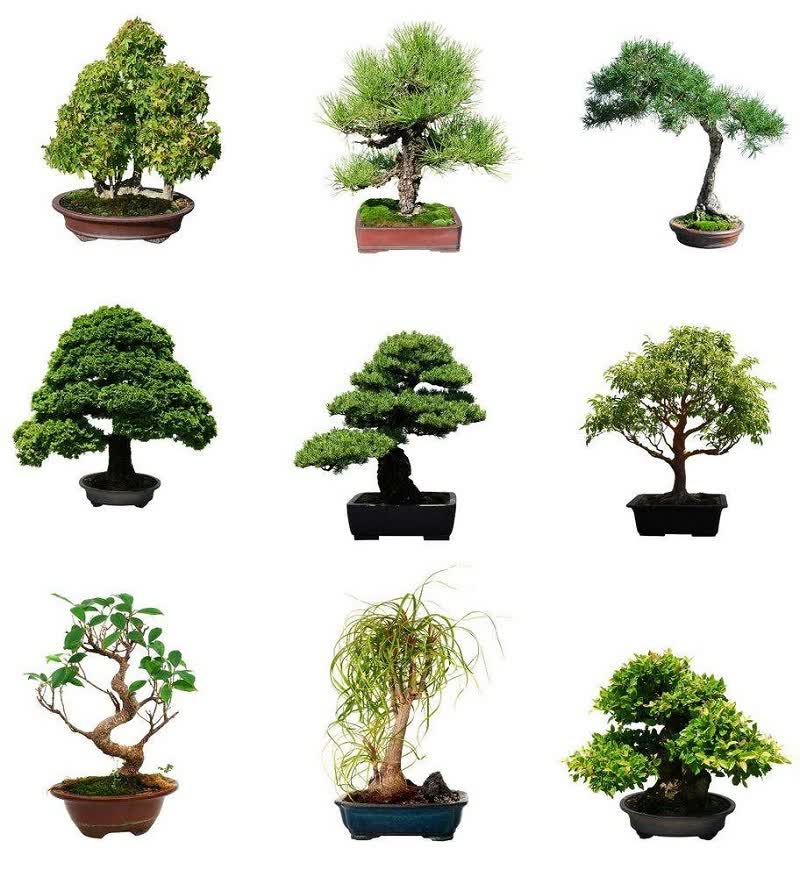
As we mentioned earlier, there are many varied types of Bonsais. Let’s go through the most popular ones.
Japanese Cherry Bonsai Tree
The Sakura cherry trees of Japan are famous all across the world and most people have seen one at least digitally by now. This beautiful tree covered in delicate pink flowers has a long and beautiful tradition of growing in Japan.
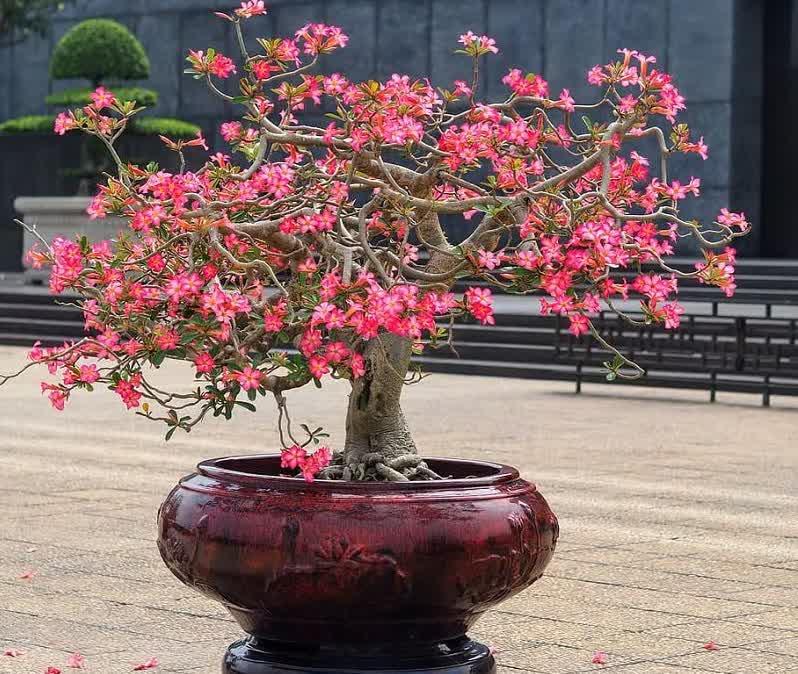
During Japan’s Nara period (710-794), the cherry blossom Sakura tree rose to fame and even became a national craze for a short while. And although the craze eventually subsided, that period still holds great significance in Japanese history, as does the Sakura tree.
Growing tip: The Sakura Bonsai is quite tricky to maintain, needing specific pruning once a year, during spring. It’s important never to let the Sakura dry out, but also not to drown it in water.
Bonsai Ficus
At the time of this writing, experts still can not agree on how many sub-types of the Ficus genus there are, but definitely somewhere between 800 and 2000.
The most popular is the Ficus Retusa, with its slightly curved trunk and its dark green leaves, and the Ficus Ginseng, with its “fat” trunk.
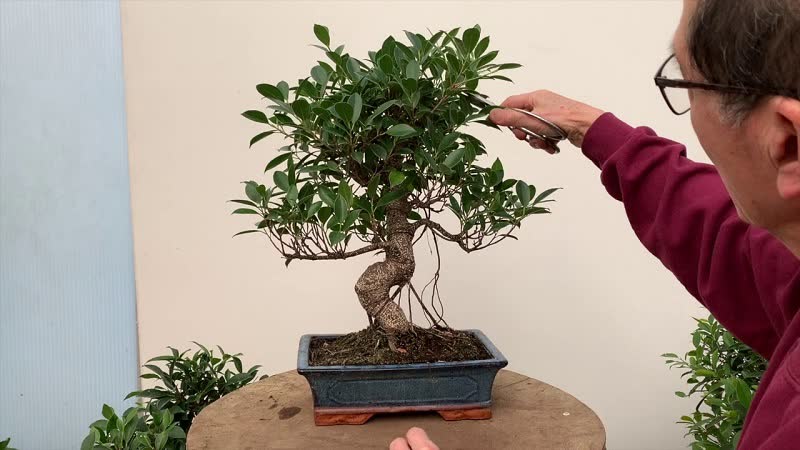
The Bonsai Ficus is excellent to start with if you are a Bonsai beginner, as it is not overly complicated to grow and can easily be grown indoors.
Growing Tip: Careful where you position it! This type of Bonsai tree is highly sensitive to frost and, while you can keep it outside during summer, you’ll need to find a cozy, warm (but not too warm) place during the cold months. It also does not do well in shade.
Ficus Benjamina Bonsai
A very interesting type of Bonsai Ficus is the Benjamina Fig. It is a dwarf variety of the Ficus species with broad leaves, and it’s easy to care for. The roots are strong and the leaves are small and easy to prune.
It bears the nickname of “weeping fig” because indoors its branches grow long and droop to the ground, making it look as if the Bonsai is crying. The Ficus Benjamina is an evergreen, meaning that with the right care, it will stay beautiful all year round.
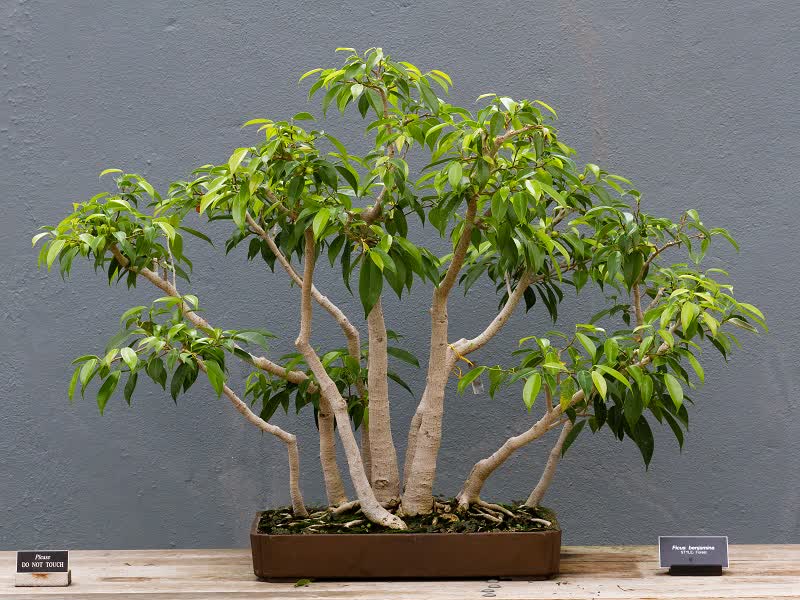
You can grow the Benjamina Fig both indoors and outdoors. It’s recommended to let it grow outdoors if you live in a tropical area so that it gets plenty of sun. But if the area where you live tends to get quite cold for longer periods, it’s best to keep this Bonsai tree indoors—it doesn’t handle frost well.
Growing Tip: Regardless of where you are growing the Benjamina Fig, one thing you have to remember is to keep its earth moist, but not soggy, as that may slow down growth.
Juniper Bonsai
The Juniper Bonsai, an evergreen genus of about 60 subspecies, is another really popular option for Bonsai beginners. They are coniferous trees that can either have the appearance of needles or look scale-like, depending on the type of Bonsai tree you’ve chosen.
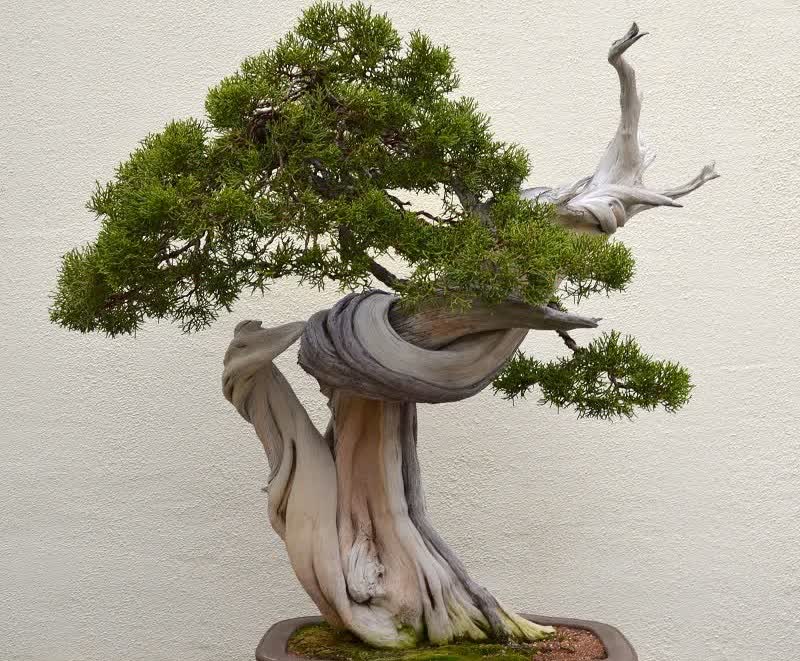
Unlike other Bonsai trees, the Juniper grows best outside. It needs plenty of sunlight. Although you should protest the Juniper Bonsai during winter, you should not take it indoors, because the Juniper can not survive inside.
Much like “real” trees, the different types of Juniper have their own frost protection mechanisms. For some, this will involve a change of shade (turning from green to a dark purple-brown). But no worries there—in the spring, they will turn green again.
Growing Tip: Allow the soil to dry slightly before you water it again, as the Juniper Bonsai does not take well to wet or soggy soil.
Japanese Maple Bonsai
The Japanese Maple Bonsai is a beautiful type of Bonsai tree, whose bark turns from a bright, deep green towards gray over the course of its life.
Its botanical name, Acer Palmatum, refers to the palm-like shape of its leaves, which often sprout five pointy lobes, just like fingers.
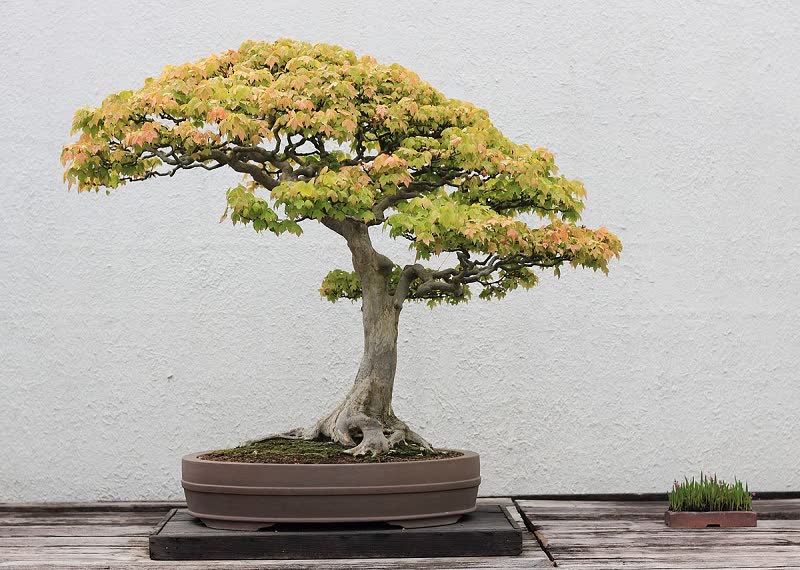
These beautiful Bonsai types bloom in May and June and give birth to tiny green-yellow flowers that just float down to the ground when mature.
It is a slightly more difficult type of Bonsai to grow, but well worth the extra effort. It’s good to remember that the Japanese Maple is a very thirsty type of Bonsai tree, which requires daily watering (even several watering sessions during hot days).
Growing Tip: The Japanese Maple enjoys spending time in direct sunlight but should be protected in the ‘peak hours’ or during really hot weather, by moving it to a shady spot. The Japanese Maple can handle cold and some frost but needs protection against really bad frosts.
Bonsai Apple Tree
We’re pretty sure what you’re wondering right now and the answer is yes, you can grow an apple tree in a small container. And yes, the Bonsai Apple Tree will give you apples right on your living room table.
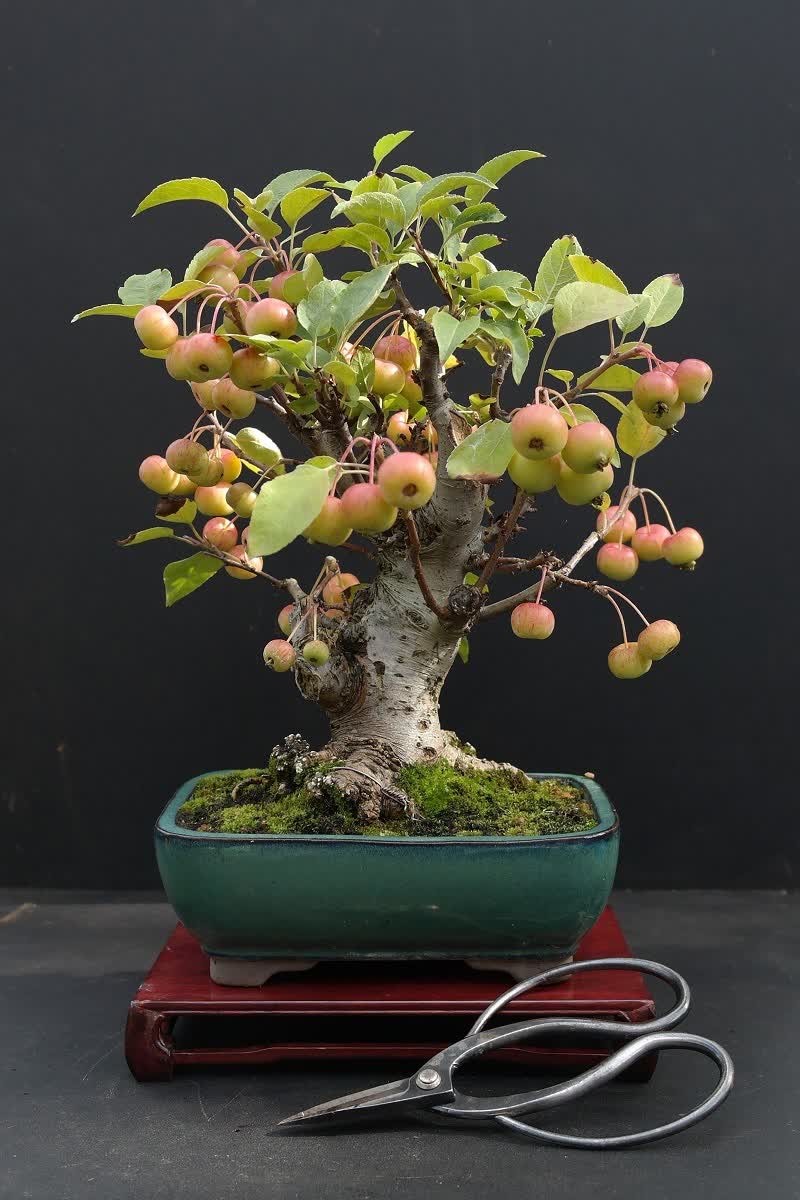
It’s another great option for those looking to grow Bonsais, as the Bonsai Apple Tree makes for a beautiful sight, especially in the warm months. In the summer, it will have dense green leaves, peppered with beautiful and fragrant pink and white flowers.
Once the flowers wither, green fruit will begin to grow, which will eventually turn into full-blown apples. It’s not only a beautiful type of Bonsai but also a practical one!
Growing Tip: Although the Bonsai Apple Tree can grow outdoors, it needs a delicate combination of sun and half-shade and doesn’t do well in frosty weather. You can grow the Bonsai Apple indoors, but make sure it gets plenty of sunlight throughout the day.
Oak Bonsai Tree
The Oak Bonsai is an interesting and very beautiful type of Bonsai and some of the evergreen subtypes can even produce the characteristic acorns.
It is a sturdy tree with heavy branches that are covered in multi-lobed leaves that give it a bit of an unusual appearance.
A great thing about the Oak Bonsai is that it is well-resistant to frost, though it can still benefit from winter protection. Most Bonsai types thrive in cold, but not frosty weather.
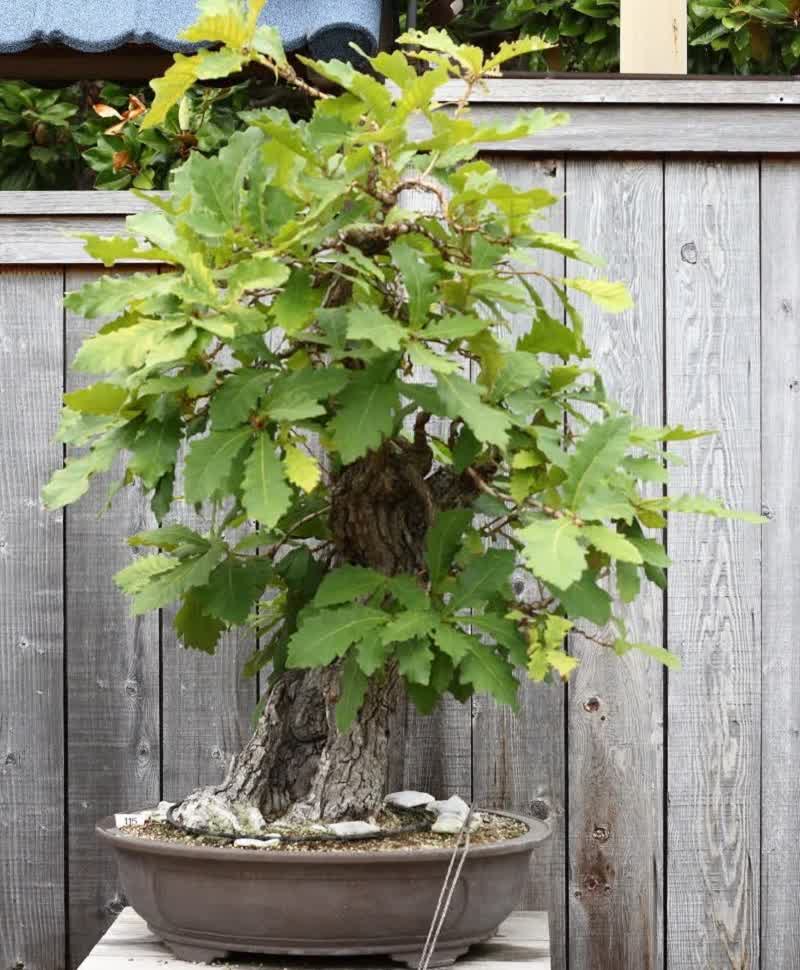
Although there are hundreds of types of Oak, by far the most popular are the European Oak and the American White Oak, both of them cold-hardy types.
Growing Tip: Although the Oak enjoys regular watering, it cannot abide soggy soil. Make sure to only water it after the soil has dried. Don’t over-water!
Ginkgo Bonsai (Ginkgo Bilboa)
No doubt you’ve heard of Ginkgo Bilboa, as it’s quite a popular addition to many health smoothies, creams, and other self-care products. Well, this is the tree where that ingredient comes from.
The Ginkgo Bonsai is a deciduous tree, meaning that it sheds its leaves annually (as opposed to an evergreen), and is one of the oldest types of Bonsai out there, dating back some 270 million years.
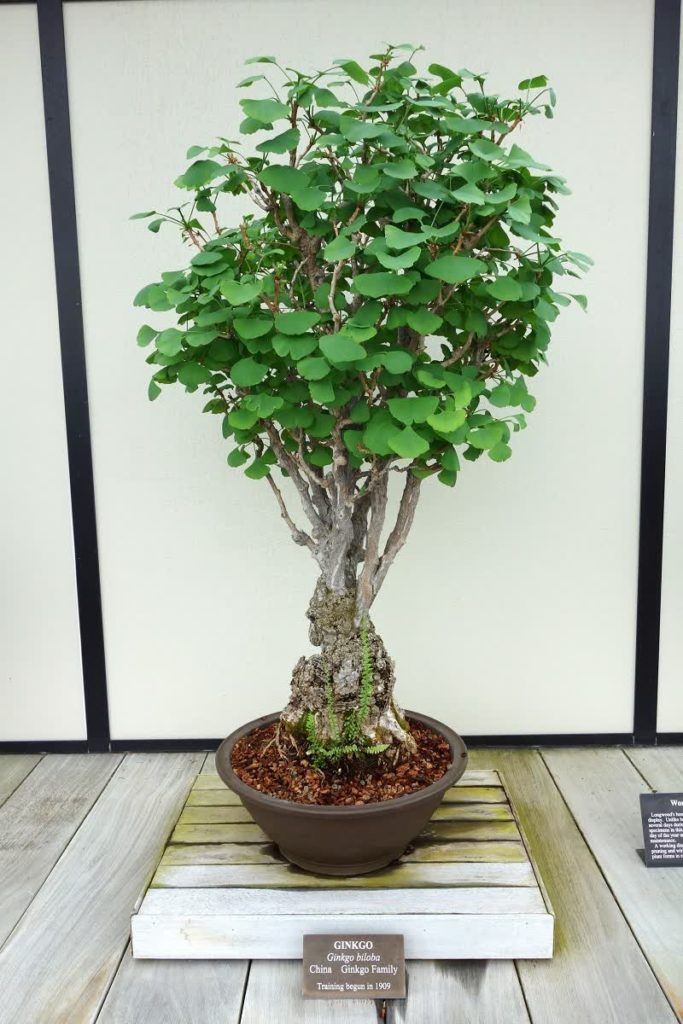
It’s a type of Bonsai whose fan-shaped leaves grow broader with age. It follows the same pattern most of us are used to. Its bright green leaves progressively turning a dull, yet beautiful yellow before falling in the autumn.
Growing Tip: The Ginkgo Bonsai is a variety of Bonsai that grows exclusively outdoors, throughout the year. As with many Bonsais, it can deal with frost, although it should be protected from extreme weather.
Japanese Winterberry Bonsai
It would be a pity to talk about the different Bonsai types without at least mentioning the mesmerizing Japanese Winterberry Bonsai, which is a special sight, even for seasoned Bonsai growers.
The female shrubs of Japanese Winter-berry bear these small and very beautiful red berries, which are long-lasting (some can last you into the next spring) and which create a fascinating contrast with the grayish-white bark of the tree.
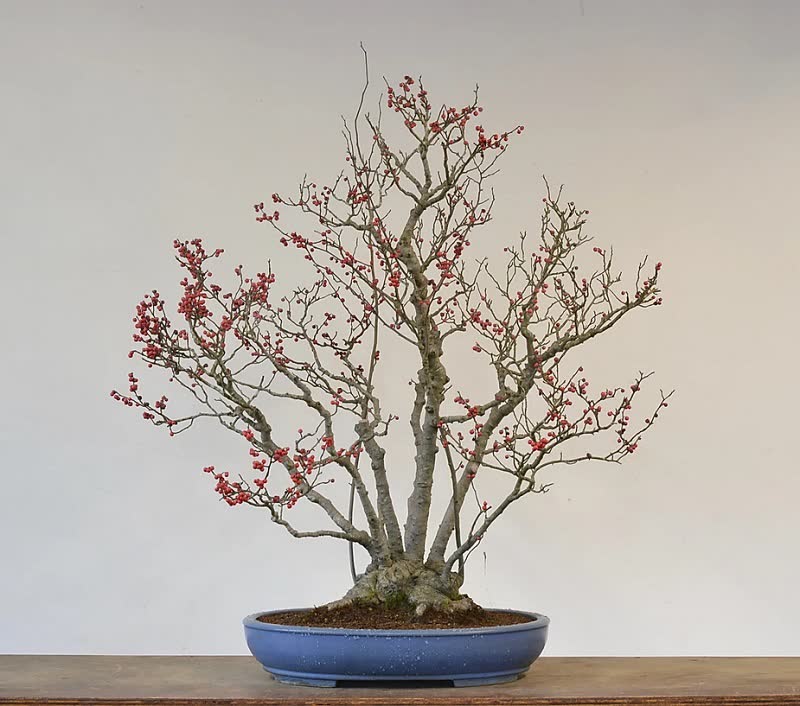
But there’s a catch—you’ll need to have both a female and a male tree of Japanese Winterberry for pollination, otherwise the berries won’t grow.
Growing Tip: The Japanese Winter-berry is an outdoor type of Bonsai and the two trees need to grow close to each other, to ensure they flower at the same time. Make sure to protect the red berries from birds, who are apt to steal them.
Chinese Quince Bonsai
We felt we had to include the Chinese Quince (quite similar to the European Quince) simply because of its beauty. It sprouts these rather large, dark green oval leaves which yellow and redden with time (the Chinese Quince is a deciduous tree).
Since the sturdy bark tends to be a deep brown color, this creates a fetching contrast with the orange-green leaves, which makes the Chinese Quince a great decorative Bonsai.
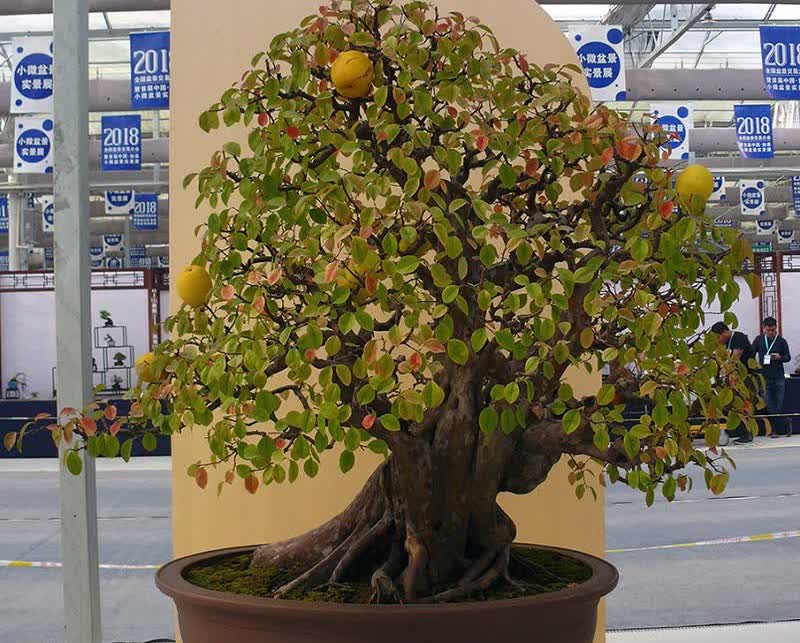
Although you can use the Quince fruits for cooking (did any say jam?), you may want to use the fruits of the European Quince instead as they are tastier.
Growing Tip: Make sure you place the Chinese Quince in a well-lit, warm spot because that’s what this type of Bonsai needs to grow and bear fruit.
Snow-rose Bonsai
This enchanting type of Bonsai goes by many names. Some call it Serissa, for its botanical name, while others refer to it as Japanese boxthorn. But by far its most appealing name, to our minds at least, is “the tree of thousand stars.”
The name refers to the Snow-rose’s minute white flowers that sprout throughout the spring and summer, and which bear a remarkable resemblance to guess what?
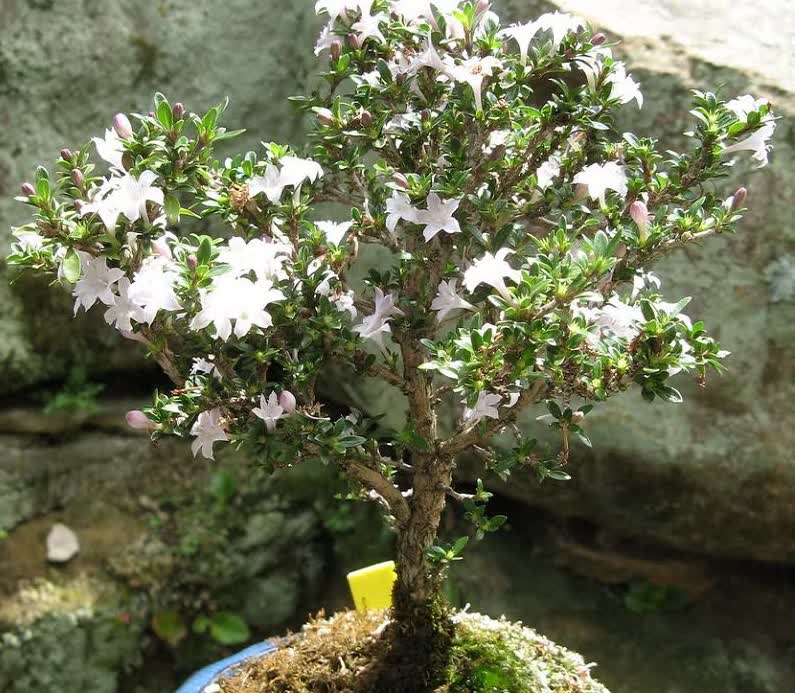
Growing Tip: The Snow-rose does not like frost and cold weather, so your best bet would be to have it outside during growing season—and take it inside from autumn to spring. Bear in mind that the Serissa does not tolerate sudden drops in temperature.
How to Grow a Bonsai Tree from a Cutting
There are several ways in which you can grow a Bonsai. Surprisingly enough, one of the most popular methods is to grow it from cuttings.
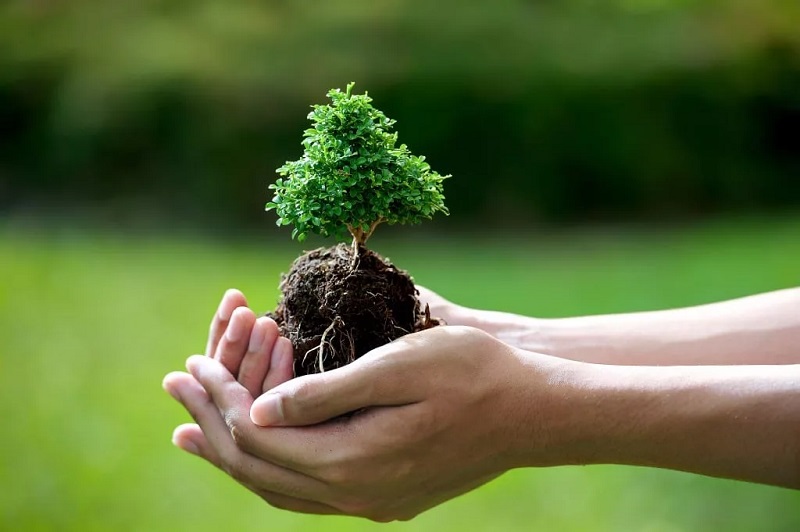
Keep in mind that this method only works if you already have a grown Bonsai tree from which you can get cuttings. Although the cutting method can work well all year round, it’s ideal that you cut and plant your Bonsai during the warm season (spring or summer).
- Begin preparing the pot in which you plan to grow the Bonsai. Select a medium-sized pot or larger, depending on the type of Bonsai tree you’ve chosen.
- Next, put down a thin layer of grit or lava rock, as this will allow the tree ample draining space (to avoid soggy soil, which may rot the Bonsai).
- Once you’ve layered the grit and smoothed it out, you can fill the rest of the container with special Bonsai soil (purchasable at most specialty stores).
- Next, you’ll want to gently prune a few cuttings from the existing Bonsai tree. Ideally, you should use a Fig (or Ficus) Bonsai to get your cuttings, as those grow quite well.
- The cuttings don’t need to be big, just small twigs with a few leaves sprouting on them. Depending on the size of the container, get as many cuttings as you deem necessary.
- When preparing the cuttings, you’ll want to cut the twig at a precise 45-degree angle, as that is optimal for Bonsai growth.
- Next, plant the twigs an inch or so in the soil and water thoroughly.
- For the next few weeks, known as the “growing period,” you’ll want to keep the soil slightly moist and water the cuttings regularly, without drowning them.
You should begin to see growth within a few weeks from planting.
Here’s a video featuring the main steps above.
How to Grow a Bonsai Tree Indoor from Seeds
If you do not already have a Bonsai tree to work from—pity!—you can just as easily plant a Bonsai from seeds. Remember, Bonsai trees are just miniature versions of actual trees, so you can get seeds from the trees in your area or buy them online.
You might see people selling “special Bonsai seeds,” but don’t fall for that—the Bonsai is just a regular tree and doesn’t need special seeds.
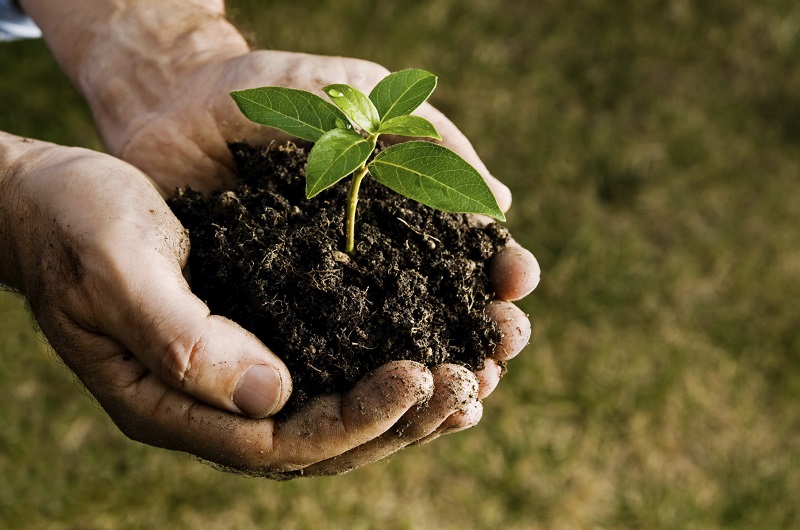
The planting of Bonsai seeds can be a bit complex and difficult to grasp if you are trying to plant the seeds out of season. In that case, you want to soak the seeds in water and keep them in your fridge for a few months to mimic the cold season. It’s easier to just plant Bonsais in early spring.
- Follow the grit + Bonsai soil combination outlined in the previous section.
- Plant the seeds individually, leaving ample space between one another.
- Bury the seeds in about an inch of soil and use your fingers to press down gently on the soil and compact it a little.
- Water the seeds thoroughly and make sure to keep moist for the next few weeks.
Growing a Bonsai from cutting and from seeds both give good results, so it’s not a matter of which is better, but rather one of availability. If you have cuttings, use those. Otherwise, try seeds.
The Best Bonsai Pots
An important aspect of growing Bonsai trees that you need to consider before you plant your first tree is the pot you’ll be using. Different Bonsais need different types of pots and you will want a sturdy and roomy container to ensure your tree grows well.
Shear Zen Bonsai Pot
This beautiful deep blue clay pot is an ideal container to begin growing your first Bonsai. Its rich color will create a wonderful contrast with most shades of green.
It’s an excellent bed for the Japanese Cherry Bonsai, the Ginkgo Bonsai, or the Japanese Maple Bonsai, among many others.
Active Gear Guy Levitating Pot
As the name suggests, this ceramic pot does indeed give the impression of floating in the air (using a unique magnetic design).
With a white, lightly floral pattern, it complements the color of any Bonsai type, not to mention it makes for a fascinating decorative piece.
Dahlia Virtue Bonsai Tree Planter Flower
This pot is inscribed with an interesting Japanese symbol pattern which only adds to the exotic nature of your Bonsai tree.
Perhaps the best part about this Bonsai container is that it comes with a specially designed drainage system, which will keep your soil moist, but not flooded.
Oval Mica Bonsai Training Pot
This dark brown mica pot looks remarkably similar to a real clay pot, but without the expense.
It helps create a great environment for the roots of your Bonsai to thrive in throughout the year. Its earthy color goes well with all types of Bonsai trees and will hold in any type of weather.
Bonsai Tree Decorative Round Plant Pot
This beautifully colored Bonsai pot comes in multiple shades, from pink to deep blue, and is an ideal option for growing a wide range of Bonsais.
Made of porcelain, it’s generally cool to the touch, but sturdy enough to hold a growing tree. It also comes with drainage and a special saucer that is not prone to leaking.
Stone-Like Ceramic Bonsai Tree Planter
Another great offering from Dahlia, this beautiful ceramic container imitates a black stone almost to perfection, giving the whole room a much more natural and exotic look.
It makes for a great home for most small Bonsai trees and comes complete with a hole at the bottom to allow drainage.
The Best Bonsai Tree Kits
Feeling a bit overwhelmed by all this information? Not sure you’ve gripped the facts firmly enough to begin growing your own Bonsai trees?
Well, not to worry, for there are many specially-designed kits out there perfect for getting you started. Discover the best ones now.
The Planter’s Choice Bonsai Starter Kit
This budget-friendly 18-piece Bonsai starter’s kit comes with four specially designed bamboo pots and saucers and a clipper to allow you to prune the Bonsais with the precision they deserve.
It also gives you seeds for four different species of Bonsai trees, including the delightful Black Poui and Rocky Mountain Bristlecone Pine.
You even get little signs to stick in the ground to remind you which is which, and a very informative booklet besides.
Garden Republic Bonsai Tree Seed Starter Kit
Similarly to the previous kit, the Garden Republic makes sure you have everything you need to begin your Bonsai journey: a clipper for pruning, four burlap specially-lined containers, and 4 Bonsai potting soil pods.
With this kit, you’ll be growing four species: Colorado Blue Spruce, Brazilian Rosewood, Black Spruce, and the “fiery” Flame Tree. Like with the previous kit, you’ll also get markers for each tree as well as an instructions manual.
Grow Buddha Grow Your Own Bonsai Kit
This pink-themed 4-Bonsai kit is a charming way to add a bit of color to your house. It comes complete with 4 pots, special name tags, clippers, and soil and allows you to cultivate the following types of Bonsai: Japanese Maple, Wisteria, Black Pine, and Judas Tree.
And to help you with planting the seeds, you get your very own instruction manual and a Premium Bonsai pot. Neat, right?
Planter’s Choice Bonsai Starter Kit
This is the slightly more complex offering from Planter’s Choice, with 24 pieces instead of 18. It contains four reusable pots with 4 pre-fertilized soil disks that expand to 8 times the initial size when watered.
With this kit, you also get premium bamboo markers, a moisture meter, and four different seeds: Rocky Mountain Pine, Royal Poinciana, Blue Jacaranda, and the dependable Norway Spruce.
The best part is, you get quite a few tools for pruning, besides the basic Bonsai clipper, like a cute bamboo rake, bamboo brush, tweezers, and scissors.
Nature’s Blossom Bonsai Tree Kit
This excellent starter’s kit will provide you with seeds for four Bonsai trees: Pinus Aristata, Ficus Religiosa, Jacaranda Mimosifolia, and the interesting Picea Mariana. You will also get 4 biodegradable pots to keep your trees in and 4 compressed soil pods.
This kit also comes complete with instructions and plant markers to differentiate between your Bonsais.
Caring for a Bonsai Tree
Now that you’ve hopefully settled on a cultivation method and/or picked a kit, let can talk a bit about caring for your Bonsai tree.
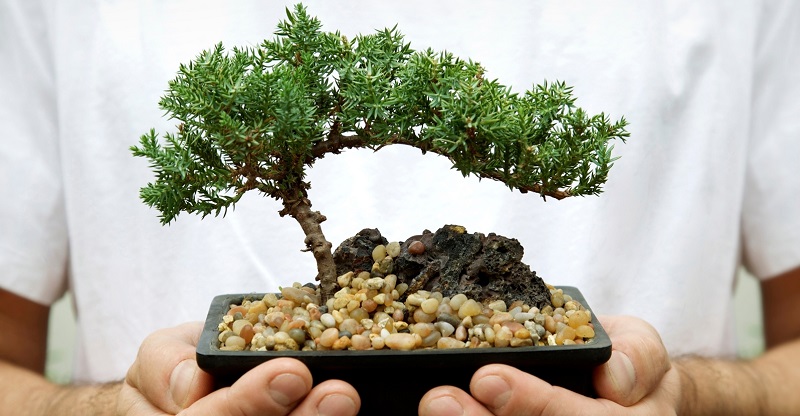
Light
If growing your Bonsai tree indoors, you need to make sure it gets plenty of light. Usually, the density of light inside the house is far lower than outside and, in time, will lead to stunted growth.
So, if you’re growing your Bonsai indoors, place it in front of a window facing the south, so that it gets plenty of light. Ideally, you can supplement this with specially designed plant-friendly fluorescent lighting for several hours a day.
Soil
You can either buy special Bonsai soil or make your own. When choosing the right soil for your Bonsai, you want to look for one that can hold water but that also encourages drainage (this is why mixing it with lava rocks of gravel is a good idea).
Temperature
While most Bonsai trees handle heat well, many of them are sensitive to cold and frost. Most Bonsais require a minimum temperature of 55 degrees Celsius during the colder months and some may need to be placed near a heat source to maintain moisture. But this varies a lot from species to species.
Water
Many Bonsai owners are guilty of under-watering, mainly because Bonsais generally take up fairly little soil and so dry out rather quickly. For most types of Bonsai trees, it’s a good idea to water them when the top-most layer of soil appears dry.
Watering frequency depends both on the type of soil and species of Bonsai you’ve chosen. Some require watering once a day or even more than that, while others only need watering every few days.
Tip: Pay more attention to how your soil feels, rather than what the label on the package says.
Fertilizer
You want to choose a fertilizer rich in Potassium, Nitrogen, and Phosphorus, with other nutrients like Iron, Boron, Zinc or Copper making for welcome additions. Make sure to fertilize your Bonsai throughout its growing season (e.g. early spring through early autumn).
How to fertilize: If using solid fertilizer for an outdoor Bonsai tree, place the right amount of fertilizer (check label) in a cup (ideally one with small holes in to allow air) that will protect it from birds. Place the cup face down at a slightly crooked angle from the root of the Bonsai. If using liquid fertilizer, apply it when you water the Bonsai.
Pruning
You will want to do regular maintenance pruning, which involves snipping away young shoots, twigs, and branches to encourage growth.
Pruning frequency and time varies from species to species, but for flowering Bonsais, it’s good to prune them in the spring, to encourage more flowers in the summer.
You can also perform structural pruning, which is done purely for decorative purposes while the tree is dormant. Structural pruning, however, is a fairly complex process. Check the video below for some tips.
Repotting
Repotting is another important aspect of Bonsai culture because excess roots may risk filling the soil and the tree may starve. Depending on how fast your Bonsai grows, you should repot it once every 2-3 years.
Tip: Remove the plant from its pot with great care and gently trim away the outer edges of the roots, keeping an eye out for rot. Before you repot, make sure to clean out the pot until it looks new and layer the bottom of the pot with new soil. Once you’re done, plant the tree on top and merge the new soil layer with the existing tree bed.
Diseases
The Bonsai tree is susceptible to a few frequent diseases:
Mold or Mildew
Mildew is a fungic growth and can appear as either a white or black substance on the leaves. Once present, Mildew can’t be cured, so you need to remove the affected leaves as soon as possible.Treat mold with a mild pesticide spray, as it’s caused by a pest infestation.
Black Spot
This is a fungus that thrives in dampness, so you must not water the tree until you’ve removed the fungus. Like with mildew, you need to remove the affected leaves as quickly as possible and spray the plant with a fungicide.
Leaf Spot
Very similar to Black Spot, except the spots appear white and progressively darken to brown. Again, you want to remove the affected areas and spray the Bonsai tree with a fungicide.
Bonsai Tree for Sale
If you don’t have the time or patience to grow a Bonsai tree from seeds, you can find some excellent Bonsai trees for sale. The Bonsai tree price is usually similar to that of a growing kit.
Zen Reflections Juniper Bonsai
The Juniper Bonsai is a wonderful choice for newcomers, as it’s very easy to care for. It symbolizes prosperity and happiness and adds a vibrant spot of color to any room.
Bonsai Tree Dragon Willow
This Dragon Willow root will grow and mature into a beautiful, slightly drooping plant that is not as bright in color as other Bonsais. It encourages serenity and peace and is fairly easy to care for.
Hawaiian Indoor Umbrella Bonsai
This beautiful tree has glossy, bright green leaves and tends to grow on an equally green mossy soil. It adds a hint of tropics to your house and its leaves resemble an umbrella.
Golden Ficus Bonsai
This seven-year-old Ficus has a beautiful, green crown, and an S-shaped, curvy trunk. It comes with detailed instructions to ensure easy care.
Mature Golden Ficus Bonsai Tree
This Bonsai Tree is very similar to the above, the only difference being that this one is ten years old. It also has a sturdier, thicker trunk and a crown of deep green leaves.
Community questions on Bonsai Trees
Again, thank you for sending in your questions and commenting on our posts with your contributions and concerns. Below the most frequently asked questions on bonsai trees we have answered so far!
Which is the best bonsai tree for beginners?
The Ficus Bonsai is one of the best Bonsai trees for beginners if the Ficus. With many different varieties, it is easy to care for and very long-lasting. But there are plenty of other varieties you should check out.
Are bonsai trees hard to care for?
People tend to assume it’s difficult to care for a Bonsai Tree. It’s not. While some species are rather complex, most are easy to keep once you understand some essential Bonsai caring rules.
How much is a real bonsai tree?
While you can purchase a variety of small, cheaper Bonsais for around $20-$30, the price of “real” Bonsai trees starts somewhere around $100 and can go up to several thousand dollars, with some even raking in millions.
What are bonsai trees good for?
Bonsais are great for many things. Just by looking at one may make you calmer and more productive. Also, a leafy Bonsai tree purifies the air in the room.
Growing an “Old” Bonsai Tree
More than a decorative item, a Bonsai tree is a bit of magic in a pot. Grow one, care for it, prune it, and you’ll understand what we mean.
Whatever some may say, growing a Bonsai tree—whether from cutting or seeds—isn’t all that hard. And if you’re at least a tiny bit into gardening, you’ll enjoy the entire process.
To sum it up, there is no reason why your Bonsai tree should not grow to maturity and enjoy a long-lasting life—as long as you follow the tips and tricks we shared with you and care for it properly.

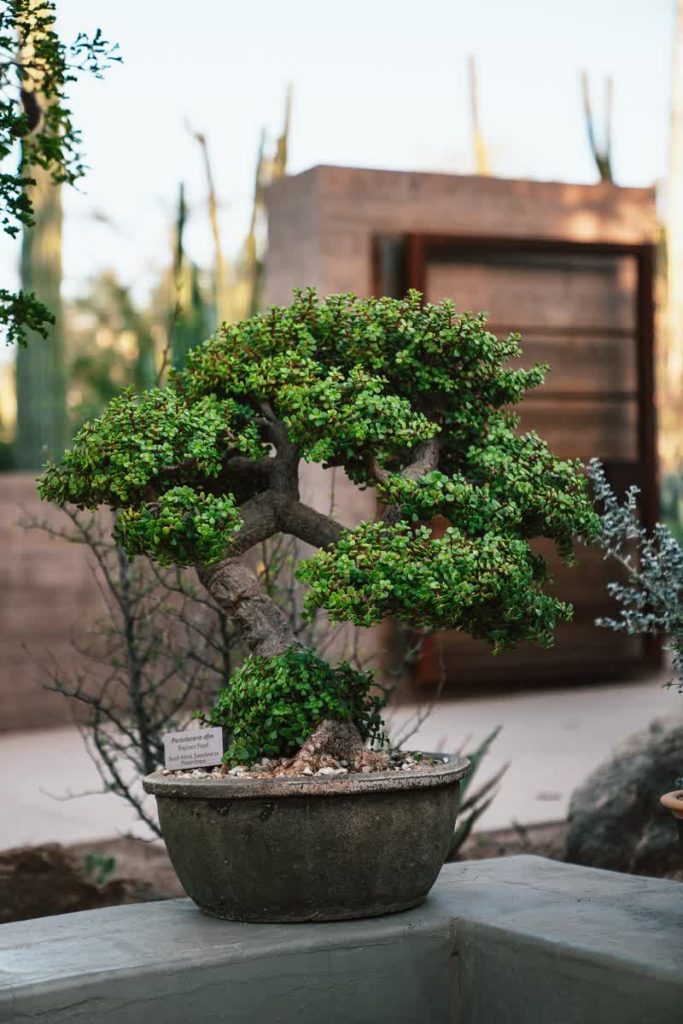
Leave a Reply